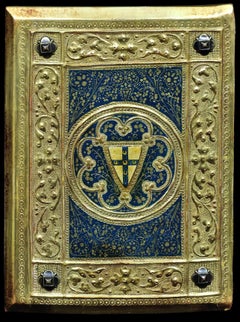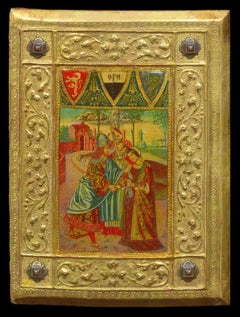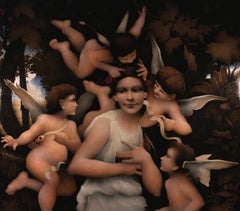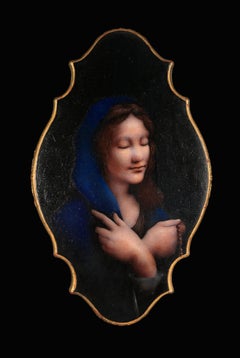Icilio Federico Joni Art
to
2
Overall Width
to
Overall Height
to
2
2
2
2
2
2
2
2
9,475
2,689
1,375
1,358
2
Artist: Icilio Federico Joni
Painted Wood Tavolette Book Cover Binding The Biccherna Aesthetic Siena Tuscany
By Icilio Federico Joni
Located in Sutton Poyntz, Dorset
Icilio Federico Joni.
Italian ( b.1866 - d.1946 ).
Painted Gesso, Gilt & Wood Tavolette Book Cover Binding In The Sienese Biccherna Aesthetic.
Book Cover size 11 inches x 8.1 inches ( 28cm x 20.5cm ).
Frame size 16 inches x 13 inches ( 40.5cm x 33cm ).
Available for sale; this painted gesso and gilt “tavolette” wooden book cover in the Biccherna aesthetic is by Icilio Federico Joni.
The book cover is mounted and supplied in a contemporary black Tulip Wood frame (which is shown in these photographs) which is glazed with non-reflective Tru Vue UltraVue® UV70 glass. The wooden book cover is curved and float mounted giving a wonderful 3D depth to its presentation.
The gesso and painted surfaces have benefitted from professional restoration which was performed on our instruction, supervision and approval.
This antique book cover is in very good condition, commensurate with its age.
The frame presentation is new and in excellent condition. Combined, it wants for nothing and is supplied ready to hang and display.
The story of these panels and of their artist is fascinating, and begins in 13th century Siena:
The Biccherna was the person who held the position of Magistrate of Chancellery of Finance from the 13th to the 14th century for the republic and the city of Siena, in the Tuscany region of Italy. The records of that office were very important because Siena was one of the earliest and most significant banking centres in Italy, and indeed in Europe. It became the fashion to keep banking and taxation records of the region in large books with painted leather covers. These were originally made from wood and leather. In the competition to make these ever more prestigious the bindings and panels on the front and rear of the books were painted by the major artists of the day, such as Giovanni di Paolo. Many of these mainly secular covers are displayed in the Archives of the State of Siena located in the Palazzo Piccolmini.
The Gothic Revival of the 19th century occurred partly as a reaction against the progress of industrialisation in Europe generally. It was however greatly affected by the unification of Italy in the second half of the 19th century. This led to the closure and downsizing of many religious institutions, which resulted in the dispersal of thousands of works of art dating from the Middle Ages and early Renaissance. Many aristocratic and bourgeois families struggled to pay debts or simply to make ends meet and so they sold off their private collections and family heirlooms. There was then an influx of goods into the antiques market which provided a great deal of work for Italy’s restorers and craftsmen, since many of these pieces were in need of cleaning, repair and, in keeping with the interventionist tastes of the times, radical restoration, before they could be sold on, often to foreign buyers. These early Italian works became so fashionable that demand soon outstripped supply. This in turn gave rise to a new type of artist-craftsman capable of turning out from scratch increasingly convincing reproductions, imitations and out-and-out fakes.
Siena naturally became the epicentre of this thriving cottage industry because of the extraordinary continuity there in traditional craft skills. This technical expertise had been handed down from generation to generation, and it was perhaps inevitable that a number of artists with real talent, the flair of commerce and a genuine love and understanding of antique Sienese art should adapt their skills to these new market conditions. Among these artists were Igino Gottardi, Alceo Dossena, Fulvio Corsini, Umberto Giunti...
Category
Late 19th Century Renaissance Icilio Federico Joni Art
Materials
Gesso, Oil, Wood Panel
Painted Wood Tavolette Book Cover Binding The Biccherna Aesthetic Siena Tuscany
By Icilio Federico Joni
Located in Sutton Poyntz, Dorset
Icilio Federico Joni.
Italian ( b.1866 - d.1946 ).
Painted Gesso, Gilt & Wood Tavolette Book Cover Binding In The Sienese Biccherna Aesthetic.
Book Cover size 11 inches x 8.1 inches ( 28cm x 20.5cm ).
Frame size 16 inches x 13 inches ( 40.5cm x 33cm ).
Available for sale; this painted gesso and gilt “tavolette” wooden book cover in the Biccherna aesthetic is by Icilio Federico Joni.
The book cover is mounted and supplied in a contemporary black Tulip Wood frame (which is shown in these photographs) which is glazed with non-reflective Tru Vue UltraVue® UV70 glass. The wooden book cover is curved and float mounted giving a wonderful 3D depth to its presentation.
The gesso and painted surfaces have benefitted from professional restoration which was performed on our instruction, supervision and approval.
This antique book cover is in very good condition, commensurate with its age.
The frame presentation is new and in excellent condition. Combined, it wants for nothing and is supplied ready to hang and display.
The story of these panels and of their artist is fascinating, and begins in 13th century Siena:
The Biccherna was the person who held the position of Magistrate of Chancellery of Finance from the 13th to the 14th century for the republic and the city of Siena, in the Tuscany region of Italy. The records of that office were very important because Siena was one of the earliest and most significant banking centres in Italy, and indeed in Europe. It became the fashion to keep banking and taxation records of the region in large books with painted leather covers. These were originally made from wood and leather. In the competition to make these ever more prestigious the bindings and panels on the front and rear of the books were painted by the major artists of the day, such as Giovanni di Paolo. Many of these mainly secular covers are displayed in the Archives of the State of Siena located in the Palazzo Piccolmini.
The Gothic Revival of the 19th century occurred partly as a reaction against the progress of industrialisation in Europe generally. It was however greatly affected by the unification of Italy in the second half of the 19th century. This led to the closure and downsizing of many religious institutions, which resulted in the dispersal of thousands of works of art dating from the Middle Ages and early Renaissance. Many aristocratic and bourgeois families struggled to pay debts or simply to make ends meet and so they sold off their private collections and family heirlooms. There was then an influx of goods into the antiques market which provided a great deal of work for Italy’s restorers and craftsmen, since many of these pieces were in need of cleaning, repair and, in keeping with the interventionist tastes of the times, radical restoration, before they could be sold on, often to foreign buyers. These early Italian works became so fashionable that demand soon outstripped supply. This in turn gave rise to a new type of artist-craftsman capable of turning out from scratch increasingly convincing reproductions, imitations and out-and-out fakes.
Siena naturally became the epicentre of this thriving cottage industry because of the extraordinary continuity there in traditional craft skills. This technical expertise had been handed down from generation to generation, and it was perhaps inevitable that a number of artists with real talent, the flair of commerce and a genuine love and understanding of antique Sienese art should adapt their skills to these new market conditions. Among these artists were Igino Gottardi, Alceo Dossena, Fulvio Corsini, Umberto Giunti...
Category
Late 19th Century Renaissance Icilio Federico Joni Art
Materials
Gesso, Oil, Tempera, Wood Panel
Related Items
Coronation of Venus
Located in Mokena, IL
Coronation of Venus, 2021
Oil on Panel with 24k Gold Water-Gilded Frame, 114 x 78 inches
“Coronation of Venus,” an ornamentally enriching piece from the studio of Justas and Vilius...
Category
21st Century and Contemporary Renaissance Icilio Federico Joni Art
Materials
Gold Leaf
Our Lady of Mercy
Located in Mokena, IL
Our Lady of Mercy, 2021
Oil on Panel with Carved and Gilded Frame, 8 x 14 inches
A work of spiritual devotion, Justas Varpucanskis’s “Our Lady of...
Category
21st Century and Contemporary Renaissance Icilio Federico Joni Art
Materials
Gold Leaf
School of Stoics
Located in Mokena, IL
The School of Stoics brings the viewer into an airy evening discussion at an agora overlooking the Aegean Sea. Amidst the silent water and grained marble, a group of stoics debate logic, reason, and nature. Agreement and disagreement prevail in the noble gestures of their bodies. Soon you see an individual's gaze directed towards you, raising their hand, calling you to join the conversation.
Technical:
53” x 39”. Tempera on panel with 24k gold water-gilded frame. Painting and frame produced by artists Justas and Vilius Varpucanskis. This piece utilizes the "rules of craftsmanship" as outlined in Cenino Cennini's Il Libro dell'Arte. 21st century contemporary artwork that employs techniques, philosophy, and visual language of the Italian High Renaissance...
Category
21st Century and Contemporary Renaissance Icilio Federico Joni Art
Materials
Gold Leaf
Eli
Located in Mokena, IL
Eli, 2020
Oil on Panel with Carved and Gilded Frame, 11.5 x 13.5 inches
An embodiment of Renaissance portraiture, Varpucanskis’s “Eli” is distinguished by its gentle charm and mat...
Category
21st Century and Contemporary Renaissance Icilio Federico Joni Art
Materials
Gold Leaf
Oil painting On Canvas On Panel, Mediterranean View With Sailboat And Cliffs
Located in Gavere, BE
Oil On Canvas On Panel, Mediterranean View With Sailboat And Cliffs ** SOLD WITHOUT FRAME **
Additional information about the work:
Title: Mediterranean View
Medium: oil on canvas...
Category
Late 20th Century Impressionist Icilio Federico Joni Art
Materials
Canvas, Oil, Wood Panel
$5,765
H 30.32 in W 20.08 in
Ritratto con paesaggio
Located in Mokena, IL
Riratto con Paesaggio, 2019
Oil on Panel with Frame, 11 x 14 inches
A quiet and contemplative portrait painting, "Ritratto con Paesaggio", by Justas Varpucanskis, presents a sooth...
Category
21st Century and Contemporary Renaissance Icilio Federico Joni Art
Materials
Oil
View of a Venetian Harbor oil painting on wood panel 2Oth C
Located in Gavere, BE
View of a Venetian Harbor oil painting on wood panel 2Oth C
Additional information about the work:
Title: View of a Venetian Harbor
Medium: oil on wooden panel
Signature: not sign...
Category
Mid-20th Century Impressionist Icilio Federico Joni Art
Materials
Oil, Wood Panel
$1,694 Sale Price
20% Off
H 11.82 in W 7.88 in
The Right Honorable R. Duck II
Located in Denver, CO
The Right Honorable R. Duck II, 2018
Category
21st Century and Contemporary Icilio Federico Joni Art
Materials
Wood Panel, Oil
Coincidental Self
By Luke Mack
Located in Denver, CO
Coincidental Self, 2018
Category
21st Century and Contemporary Icilio Federico Joni Art
Materials
Oil, Wood Panel
The Right Honorable R. Duck I
Located in Denver, CO
The Right Honorable R. Duck I, 2018
Category
21st Century and Contemporary Icilio Federico Joni Art
Materials
Wood Panel, Oil
Shell
By Karen Offutt
Located in Denver, CO
Shell, 2017
Category
21st Century and Contemporary Icilio Federico Joni Art
Materials
Oil, Wood Panel
Identity Drift
By Luke Mack
Located in Denver, CO
Identity Drift, 2018
Category
21st Century and Contemporary Icilio Federico Joni Art
Materials
Oil, Wood Panel
Icilio Federico Joni art for sale on 1stDibs.
Find a wide variety of authentic Icilio Federico Joni art available for sale on 1stDibs. You can also browse by medium to find art by Icilio Federico Joni in gesso, oil paint, paint and more. Not every interior allows for large Icilio Federico Joni art, so small editions measuring 13 inches across are available. Icilio Federico Joni art prices can differ depending upon medium, time period and other attributes. On 1stDibs, the price for these items starts at $10,096 and tops out at $10,096, while the average work can sell for $10,096.



